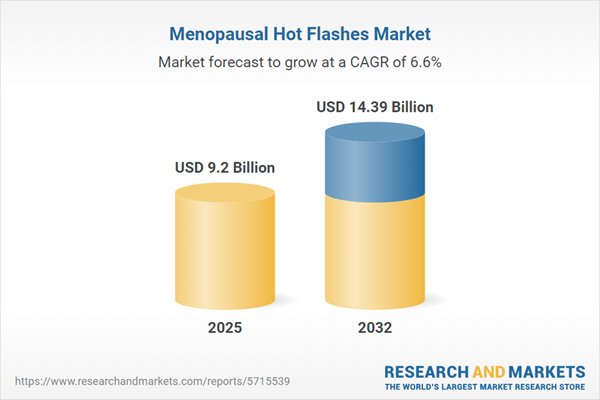Speak directly to the analyst to clarify any post sales queries you may have.
The menopausal hot flashes market is experiencing a transformative period due to evolving therapies and patient-centered care models, creating new opportunities for industry leadership and strategic growth. Stakeholders must navigate emerging clinical, regulatory, and market trends to maintain competitiveness and responsiveness.
Market Snapshot: Menopausal Hot Flashes Market Overview
The Menopausal Hot Flashes Market grew from USD 8.64 billion in 2024 to USD 9.20 billion in 2025. It is projected to continue expanding at a CAGR of 6.58%, ultimately reaching USD 14.39 billion by 2032. This robust growth is propelled by a confluence of scientific advancements, shifting demographics, and greater attention to symptom management within a patient-focused framework. Industry participants face new demands for innovation, real-world value, and effective engagement strategies as healthcare delivery and patient expectations evolve.
Scope & Segmentation
- Product Types: Complementary therapies (including Black Cohosh, Dong Quai, Isoflavones), hormonal therapy options (combined estrogen-progestin, oral, topical, transdermal estrogen, selective estrogen receptor modulators), and non-hormonal therapies (Clonidine, Gabapentin, as well as selective serotonin reuptake inhibitors such as Fluoxetine, Paroxetine, Sertraline) constitute the diversity of available solutions.
- Distribution Channels: Clinics, hospital pharmacies (private and public), company websites, and e-commerce platforms facilitate market access and patient engagement.
- Age Groups: The report examines adoption patterns across 40 to 50, 51 to 60, and above 60 age cohorts, revealing distinct preferences and outcomes.
- Geographies Covered: The analysis encompasses the Americas (including North America and Latin America), Europe, Middle East & Africa, and Asia-Pacific. Major regional markets such as the United States, Canada, Brazil, Germany, China, and India are studied for demand trends, regulatory environments, and adoption drivers.
- Companies Profiled: Leading industry players include AbbVie Inc., Pfizer Inc., Bayer AG, Merck & Co., Inc., Teva Pharmaceutical Industries Ltd., Mylan N.V., GlaxoSmithKline plc, Novartis AG, Amgen Inc., and Astellas Pharma Inc.
Key Takeaways for Stakeholders
- Scientific advances in selective estrogen receptor modulators and new delivery systems are supporting improved safety profiles and patient adherence.
- Complementary and botanical therapies are gaining traction, particularly among segments seeking non-hormonal or natural interventions.
- Digital platforms and telehealth solutions are enabling personalized symptom monitoring, treatment adjustments, and expanded patient access.
- Segmentation analysis highlights differing needs by age cohort, with early adopters in younger groups and quality-of-life enhancements prioritized by older adults.
- Regional differences in reimbursement, clinician awareness, and cultural acceptance drive divergent commercialization strategies globally.
- Strategic alliances, M&A activity, and integration of digital tools are shaping innovation pipelines and competitive positioning.
Tariff Impact and Market Adaptation
The proposed United States tariffs for 2025 introduce additional complexity into supply chain and pricing strategies for menopausal therapies. Potential increases in raw material and finished product costs may necessitate shifts toward domestic manufacturing and revised sourcing models. Organizations are proactively assessing scenarios to maintain uninterrupted supply and market access while managing budget constraints and reimbursement negotiations. Close attention to regulatory changes and collaborative scenario planning will support both immediate adaptation and long-term innovation.
Methodology & Data Sources
This research utilized a blend of primary and secondary data collection, including expert interviews with specialists, structured patient surveys, and a review of regulatory filings and peer-reviewed literature. Quantitative findings were validated through cross-source triangulation, and qualitative insights were evaluated for consistency and applicability. Scenario modeling and sensitivity analysis underpinned the assessment of market drivers and external risk factors.
Why This Report Matters
- Equips senior decision-makers with actionable insights to address emerging clinical, commercial, and regulatory trends in menopausal hot flashes management.
- Enables targeted investment decisions by offering granular segmentation and region-specific analysis relevant to market entry and expansion.
- Supports strategic planning with evidence on technology-driven care models, regulatory shifts, and evolving patient preferences.
Conclusion
This report delivers a comprehensive view of a dynamic therapeutic area where continuous innovation, regulatory vigilance, and patient-centric strategies are key. Senior leaders can leverage these insights to refine their growth blueprints and meet the evolving needs of those experiencing menopausal hot flashes.
Additional Product Information:
- Purchase of this report includes 1 year online access with quarterly updates.
- This report can be updated on request. Please contact our Customer Experience team using the Ask a Question widget on our website.
Table of Contents
3. Executive Summary
4. Market Overview
7. Cumulative Impact of Artificial Intelligence 2025
Companies Mentioned
The companies profiled in this Menopausal Hot Flashes market report include:- AbbVie Inc.
- Pfizer Inc.
- Bayer AG
- Merck & Co., Inc.
- Teva Pharmaceutical Industries Ltd.
- Mylan N.V.
- GlaxoSmithKline plc
- Novartis AG
- Amgen Inc.
- Astellas Pharma Inc.
Table Information
| Report Attribute | Details |
|---|---|
| No. of Pages | 195 |
| Published | November 2025 |
| Forecast Period | 2025 - 2032 |
| Estimated Market Value ( USD | $ 9.2 Billion |
| Forecasted Market Value ( USD | $ 14.39 Billion |
| Compound Annual Growth Rate | 6.5% |
| Regions Covered | Global |
| No. of Companies Mentioned | 11 |









